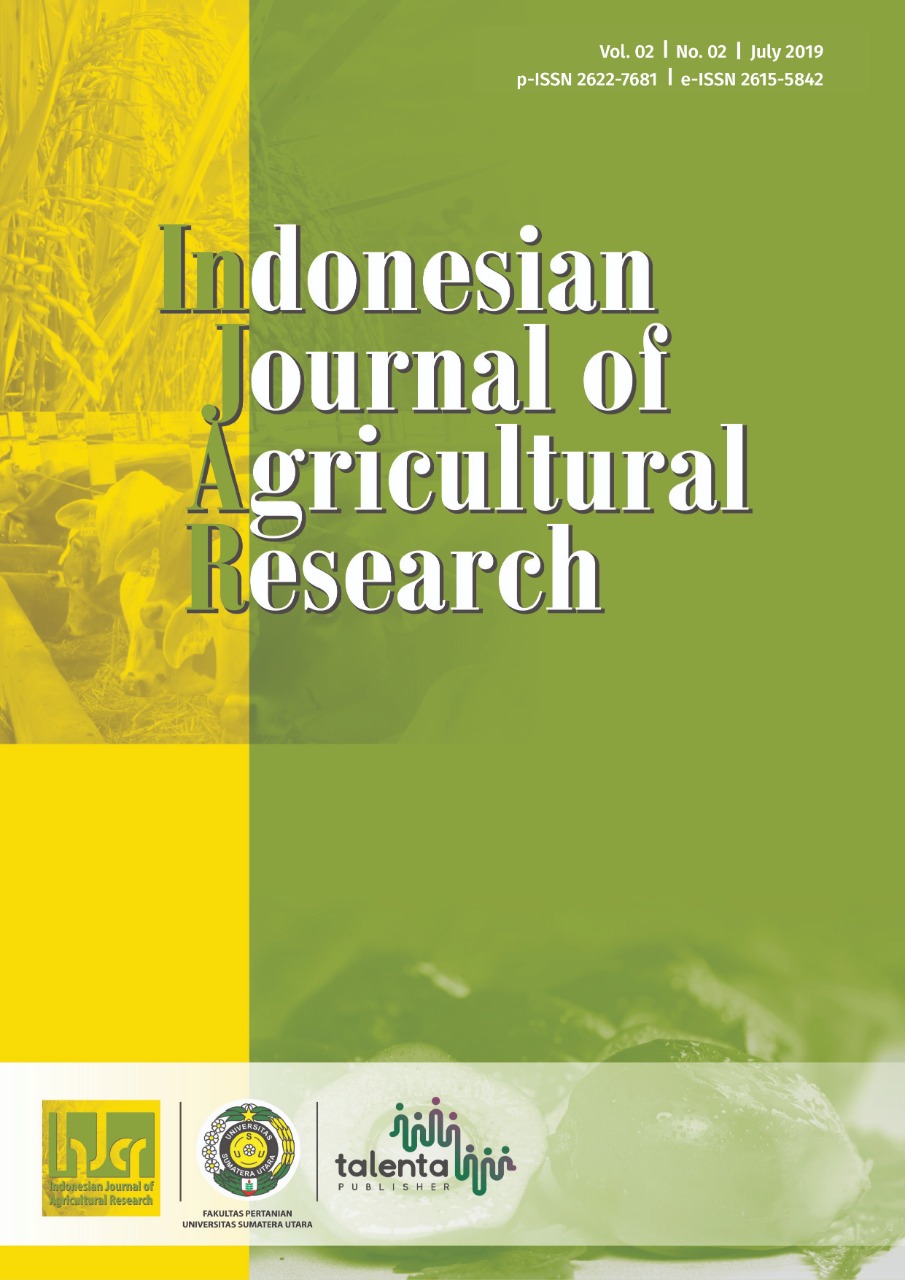Growth and Production Response of Corn (Zea mays L.) by Bokashi of Cow Waste and Tempe Industrial Liquid Waste
DOI:
https://doi.org/10.32734/injar.v2i2.917Keywords:
bokashi, corn, industrial liquid, waste tempeAbstract
The study aims to investigate the response of growth and production of the corn plant (Zea mays L.) due to the provision of bokashi cow dung and Tempe industrial liquid waste. This study was conducted in February 2017 until June 2017 at Lahan Perkebunan Rakyat Jalan Manunggal Ujung, Desa Bandar Klippa, Kecamatan Percut Sei Tuan, Medan Tembung. The design used was Factorial Randomized Block Design (RBD) with 3 replications and consisted of two factors studied: Bokashi consisting of four levels, e.i : B0 : Control, B1 : 15 ton/ha, B2 : 30 ton/ha and B3 : 45 ton/ha. The use of industrial liquid waste Tempe consisting of four levels, namely, e.i: L0 : Control, L1 : 30 ml/l, L2 : 60 ml / l, L3 : 90 ml/l. The observation data was followed by Duncan Multiple Range Test (DMRT). The results showed that the use of bokashi cow dung had a significant effect on the observation parameters of height, leaf length and cob weight in corn plants that have been observed and not significant to the observation of leaf number, leaf area, dry seed weight each plot. The use of industrial effluent of Tempe has a significant effect on leaf length parameter at age 6 weeks after planting and cob weight/plant each plot but not significant effect on observation of plant height, leaf number, leaf area, dry seed weight each plot.
Downloads
References
Purwono and R. Hartono, Bertanam Jagung Unggul. Jakarta: Penebar Swadaya, 2005.
N. Ayunda, Jamilah, and Ediwirman, “Pertumbuhan dan hasil tanaman jagung manis (Zea mays saccharata Sturt.) pada beberapa konsentrasi sea minerals,†Fakultas Pertanian, Universitas Taman Siswa, Padang, 2013.
K. Panjaitan, Prestasi genotip heritablitas dari beberapa populasi maju, 2004.
Katriani, M. Ramly, and Jumriah, “Pertumbuhan dan Hasil Tanaman Kacang Tanah pada Berbagai Dosis Bokashi Pupuk Kandang Ayam,†Jurnal Agrivigor, vol. 3, no. 2, pp. 128-135, 2003.
W. J. Rinsema, Pupuk dan Cara Pemupukan. Jakarta: Bharata, 1983.
H. O. Buckman and N. C. Brandy, The Nature and Properties of Soils, 7th Ed., The Macmillan Company, 1969.
B. Latarang and A. Syakur, “Pertumbuhan dan hasil bawang merah (Allium ascalonicum L.) pada berbagai dosis pupuk kandang,†Jurnal Agroland, vol. 13, no. 3, pp. 265-269, 2006.
A. Djunaedy, “Pengaruh jenis dan dosis pupuk bokashi terhadap pertumbuhan dan hasil kacang panjang (Vigna sinensis L.). Jurnal Agrovigor, vol. 2, no. 1, pp. 42-46, 2009.
B. Lakitan, Fisiologi Pertumbuhan dan Perkembangan Tanaman. PT Raja, 1996.
E. W. Ressel, Soil Condition and Plan Growth. 9th Ed., London: Longmants Co. Ltd., 1961.
Isrun, “Pengaruh dosis pupuk P dan Jenis pupuk kandang terhadap beberapa sifat kimia tanah, serapan P dan hasil jagung manis (Zea mays var. saccharata) pada Inceptisols Jatinangor,†Jurnal Agrisains, vol. 7, no.1, pp. 9-17, 2006.
B. Fratama, S. P. Hastuti, and S. Santoso, “Pemanfaatan limbah cair industri tempe sebagai Pupuk Cair Produktif (PCP) ditinjau dari penambahan pupuk NPK,†Prosiding Seminar Nasional Sains dan Pendidikan Sains VIII, Fakultas Sains dan /Matematika, UKSW Salatiga,. vol. 4, no. 1, 2013.
F. G. Dewanto, J. J. M. R. Londok, R. A. V .Tuturoong, and W. B. Kaunang, “Pengaruh pemupukan anorganik dan organik terhadap produksi tanaman jagung sebagai sumber pakan†Jurnal Zootek, vol. 32, no. 5, pp. 1-8, 2013.
M. M. D. Damanik, B. E. Hasibuan, Fauzi, Sarifuddin, and H. Hanum, Kesuburan Tanah dan Pemupukan. Medan: USU Press, 2011.
Downloads
Published
How to Cite
Issue
Section
License
Copyright (c) 2019 Indonesian Journal of Agricultural Research

This work is licensed under a Creative Commons Attribution-ShareAlike 4.0 International License.



















